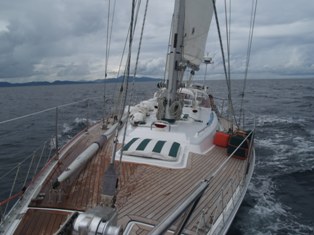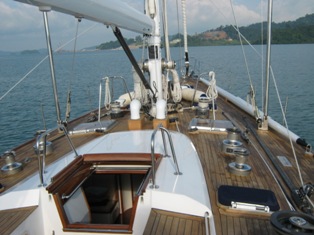OUR CODE OF ETHICS
- Siam Surveyors will conduct ourselves in accordance with the standards and laws of the countries in which we perform our surveys.
- Siam Surveyors will only accept assignments that we are qualified to perform.
- Siam Surveyors will perform our duties as Marine Surveyors at a high level of professional competence.
- Siam Surveyors will not accept assignments that place us in conflicting roles that may bias our judgment.
- Siam Surveyors compensation will not be accepted from a second party without the full knowledge of all parties concerned.
- Siam Surveyors will not disclose privileged information to a third party without the express permission of the party who appointed us.
- Siam Surveyors will advertise in a professional manner avoiding misrepresentation or exaggeration.
- Siam Surveyors will not deny professional service or discriminate against any person for reasons of creed, race, age, or country of origin.
- Siam Surveyors will not seek unfair advantage over other Marine Surveyors nor will we publicly disparage the performance of another Marine Surveyor.
- Siam Surveyors will work to the mutual benefit of the Marine Surveying profession by expressing a will to share lessons of experience with fellow Marine Surveyors, Brokers, Underwriters and Lending Institutes.
The following is some information to help you understand your survey and to assist you in making your survey compliant.
Definition of Findings
A condition and Value survey of an average sized (45 foot) used vessel normally takes us some 28 hours to conduct, including the report. Findings will be divided into three categories, “Major” findings which are structural defects or items which would put the vessel at imminent risk. “Safety” findings which are items which will affect the well being of on board passengers or crew, and “Minor” findings which will include every other item we see. The “Minor” list will become your work list and really is the product of a used boat, or the reason you are not paying an “as new” price for the vessel.

On a new vessel however, all findings become an issue to be discussed with the builder.
The length and detail of the report depends on the condition, purpose and size of the vessel. For example, a survey for Underwriting purposes will be less detailed with more emphasis on structural issues.
If a vessel has many findings, obviously this report will be longer with considerable detail on the findings and recommendations, whereas an uncluttered, well maintained vessel will have a shorter report. Our reports vary from 30 to 60 pages with embedded pictures.
Since Thailand is a Member of ISO (the International Standards Organization), we use these standards in the conduct of our surveys and refer findings to the relevant ISO standard.
THE FOLLOWING IS A LIST OF SAFETY EQUIPMENT WE WILL BE LOOKING FOR, IT WILL HELP IF YOU ENSURE THAT YOU COMPLY.
PERSONAL FLOTATION DEVICES (PFD’s):
- PFD’s must be in good and serviceable condition and of appropriate size for the intended user. Wearable PFD’s must be readily accessible.
- Throwable devices must be immediately available for use.
- Boats less than 16’ in length (including canoes and kayaks of any length) must be equipped with one type I, II, III, IV or V PFD for each person aboard.
- Boats 16’ and longer must be equipped with one type I, II, III or V PFD for each person aboard PLUS one type IV.
Type I PFD = Off-shore life jacket (all waters).
Type II PFD = Near-shore buoyancy vest (calm inland waters).
Type III PFD = floatation aid life jacket (calm inland waters).
Type IV PFD = Throwable device (Calm inland waters where help is readily available).
Type V PFD = Special use or inflatable (work, water ski etc.).
VISUAL DISTRESS SIGNALS:
The following vessels are not required to carry day signals but must carry night signals when operating from sunset to sunrise:
- Recreational boats less than 16’ in length.
- Boats participating in organized events such as races, regattas or marine parades.
- Open sailboats less than 26’ in length not equipped with propulsion machinery.
- Manually propelled boats.
Pyrotechnic Visual Distress Signals must be approved, in serviceable condition and readily accessible and include:
- Pyrotechnic red flares, hand held or aerial.
- Pyrotechnic orange smoke, hand held or floating.
- Launchers for aerial red meteors or parachute flares.
Non-pyrotechnic Visual Distress Signals must be in serviceable condition, readily accessible, and certified and include:
The following illustrates the variety and combination of devices which can be carried in order to meet the requirements:
- Three hand held red flares (day and night).
- One hand held red flare and two parachute flares (day and night).
- One hand held orange smoke signal two floating orange smoke signals (day) and one electric distress light.
FIRE EXTINGUISHERS:
The minimum number of hand portable extinguishers required:
- Vessel less than 26’ with no fixed system, 1 B-I. With approved fixed system, 0
- Vessel 26’ to less than 40’ with no fixed system, 2 B-I or 1 B-II. With approved fixed system, 1 B-I.
- Vessels 40’ to 65’ with no fixed system, 3 B-I or 1 B-II and 1 B-I. With approved fixed system, 2 B-I or 1 B-II.
B-I = 1.25 gals. Foam, 4 lbs dry co2 or 2 lbs chemical.
B-II = 2.5 gals foam, 15 lbs dry co2 or 10 lbs chemical.

SOUND PRODUCING DEVICES:
Vessels 12 meters or more in length are required to carry on board a whistle or horn,
and a bell. Vessels less than 12 meters in length are required to make an efficient sound signal.
NAVIGATION LIGHTS:
Navigation lights must be carried aboard all vessels in accordance with SOLAS requirements.
ANCHORING:
All vessels must be equipped with an anchor and line of suitable size and length for the waters in which it is operating.
VENTILATION:
All vessels built after April 25th, 1940 which use gasoline (petrol) for electrical generation, mechanical power or propulsion are required to be equipped with a ventilation system for engine or fuel tank compartments.
DEWATERING DEVICE:
All vessels must carry at least one effective manual device (portable bilge pump, bucket, etc.) for bailing water, in addition to any installed electric bilge pump.
SOLAS:
The following is a list of requirements for passenger carrying vessels over 30 tons:
- Adequate lifeboat seating for all passengers.
- SART (search and rescue transponders) to make lifeboat visible on radar & be tracked by IMO satellite based GMDSS (global maritime distress and safety system. (not mandatory).
- Lifejackets should keep the wearer upright even if unconscious, plus 5% spares.
- Fire extinguishers in Galley, Bridge, engine spaces and cabins.
- At least 2 type IV PFD’s.
|